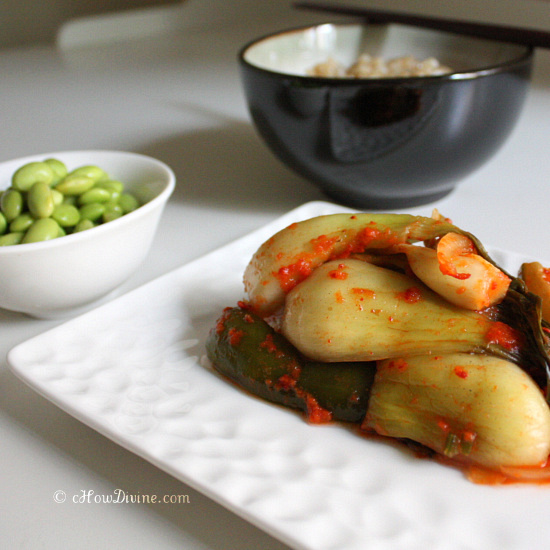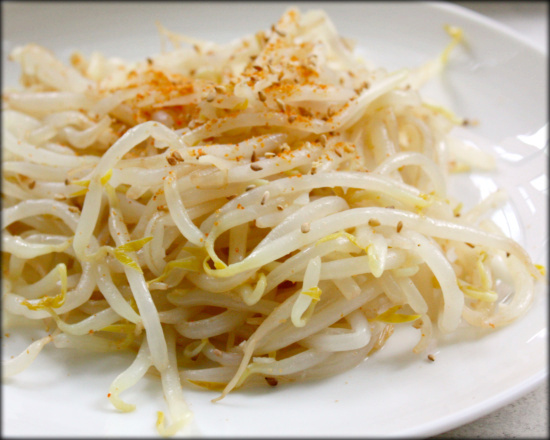I had the benefit of growing up with a wonderful grandmother who showered me with love and lots of homemade food. We always had at least two or three types of kimchi in the fridge. My grandmother was always in the kitchen whipping up different types of kimchi as well as other delectable dishes. She introduced me to many of the dishes I still enjoy as an adult. And whatever I wanted to eat, she was more than happy to cook. Some of our family members believed she was too indulging. Maybe she was, but her love wasn’t lost on me; I loved her back with all of my heart. She is no longer around. And I miss her.
Kkakdugi (Radish Kimchi)
I made Kkakdugi (Radish/Daikon Kimchi) over the weekend. And my home-made Kkakdugi turned out so delicious! It made me wonder why I don’t do this more often. And to think, I only decided to make it because of a troubling ingredient in my store-bought Kkakdugi/Kimchi. I guess it was a blessing in disguise.
I was reading the ingredients of my go-to, store-bought kimchi the other day. And to my shock, my “preservative-free” kimchi contained MSG. I guess the “preservative-free” on the label gave me a false sense of comfort (well, enough comfort not to check out the ingredients for 3+ years!). I know; MSG is not a preservative. And it’s not false advertising. But I’m sorely disappointed that my go-to kimchi is not the probiotics-filled, all-natural goodness I once thought it was.
So I decided to make my own probiotics-filled, all-natural Kkakdugi (Radish Kimchi) – sweetened with fruit and honey, instead of sugar. Kkakdugi is traditionally made with Mu (or Moo) – Korean radish. Mu is usually thicker and shorter than a Daikon. But if you can’t find Mu at your local grocers, Daikon is a good substitute; that’s what I’m using.
Luckily, Kkakdugi is pretty easy to make. And you can make it in relatively short amount of time. So if this is your first foray into Kimchi-making, I highly recommend Kkakdugi. Not only is it easy, it’s probably the most foolproof of all Kimchi.
And let me tell you. It is so delicious and totally worth the effort.
Kongnamul Muchim (Korean Soybean Sprouts Banchan)
I was not a fan of Kongnamul Muchim (Korean Soybean Sprouts Banchan/Side Dish) when I was young. I hated beans of any and all kinds. I couldn’t stand the taste, texture, and the smell of them. In fact, I used to take the “Kong” – which directly translates to “bean” in Korean – off of the Kongnamul and eat only the sprout end. That was then. This is now.
Maybe your taste buds change as you get older. But there are so many things I hated as a kid that I actually love today; Kongnamul is one of them. You may think that Kongnamul and Sukju Namul are so similar in appearance that their taste may also be indistinguishable. So if I liked Sukju Namul, how could I not have liked Kongnamul? Au contraire. Kongnamul has a unique crunchy texture, nutty aroma and taste that is completely different from anything else.
Shigumchi Namul (Korean Seasoned Spinach)
Shigumchi Namul or Sigumchi Namul is an integral part of many popular Korean dishes. Yes; you can most certainly serve it on its own as a respectable banchan (side dish). But Shigumchi Namul is much more than that. You can bring color, flavor, and nutrients to many main dishes simply by adding it as an ingredient. Bibimbap (mixed rice), Kimbap (rolled rice in laver), and Japchae (mixed or stir-fried cellophane noodles) are the first to come to mind.
Shigumchi Namul is a classic Korean side dish. But I prepare it a bit differently than my foremothers. I water-sauté the spinach instead of boiling it. When you boil the spinach, you have to wait for the water to boil; and after boiling, you have to squeeze out the water from the spinach. I know. It sounds a bit counter-intuitive. But that’s how it’s traditionally done. The water-sauté method saves me a lot of time and energy by allowing me to dispense with those steps. And the end product tastes just as delicious.
Sukju Namul Muchim (Korean Seasoned Mung Bean Sprouts)
All those side dishes you get when you eat at a Korean restaurant? Those dishes, along with the seemingly infinite number of other Korean side dishes, are collectively called banchan. And many of those banchan are used to make traditional bibimbap. I made No-Cook Vegan Bibimbap last week, but now that the temperature has gone down a little bit in NYC, I’m hankering for a traditional bibimbap. So this week, I will prepare some of the vegetable banchan required for the recipe. Sukju Namul (or Sookju Namul), Korean Seasoned Mung Bean Sprouts, is first on the list.
I love Sukju Namul. Whenever there was a traditional Korean function, my grandmother always made this. There are many ways to serve this dish. You can simply serve it with warm rice. You can add it as an ingredient in bibimbap. You can also put it in Moo Guk (Korean radish soup). In fact, when my grandmother used to make this for the traditional ancestral remembrance celebration (“Jaesa”), we used to eat it with Moo Guk on the day of the celebration, in bibimbap the next day, and as a side dish(banchan) the day after if we had any left. It’s a really versatile, simple, and healthy dish.





